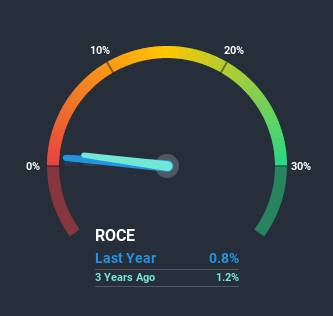- India
- /
- Energy Services
- /
- NSEI:JINDRILL
Should You Be Worried About Jindal Drilling & Industries' (NSE:JINDRILL) Returns On Capital?

When we're researching a company, it's sometimes hard to find the warning signs, but there are some financial metrics that can help spot trouble early. More often than not, we'll see a declining return on capital employed (ROCE) and a declining amount of capital employed. This reveals that the company isn't compounding shareholder wealth because returns are falling and its net asset base is shrinking. So after we looked into Jindal Drilling & Industries (NSE:JINDRILL), the trends above didn't look too great.
Return On Capital Employed (ROCE): What is it?
For those who don't know, ROCE is a measure of a company's yearly pre-tax profit (its return), relative to the capital employed in the business. To calculate this metric for Jindal Drilling & Industries, this is the formula:
Return on Capital Employed = Earnings Before Interest and Tax (EBIT) ÷ (Total Assets - Current Liabilities)
0.0077 = ₹123m ÷ (₹18b - ₹2.3b) (Based on the trailing twelve months to March 2020).
Therefore, Jindal Drilling & Industries has an ROCE of 0.8%. In absolute terms, that's a low return and it also under-performs the Energy Services industry average of 17%.
Check out our latest analysis for Jindal Drilling & Industries

While the past is not representative of the future, it can be helpful to know how a company has performed historically, which is why we have this chart above. If you want to delve into the historical earnings, revenue and cash flow of Jindal Drilling & Industries, check out these free graphs here.
The Trend Of ROCE
In terms of Jindal Drilling & Industries' historical ROCE movements, the trend doesn't inspire confidence. About five years ago, returns on capital were 7.4%, however they're now substantially lower than that as we saw above. And on the capital employed front, the business is utilizing roughly the same amount of capital as it was back then. Companies that exhibit these attributes tend to not be shrinking, but they can be mature and facing pressure on their margins from competition. So because these trends aren't typically conducive to creating a multi-bagger, we wouldn't hold our breath on Jindal Drilling & Industries becoming one if things continue as they have.
What We Can Learn From Jindal Drilling & Industries' ROCE
In the end, the trend of lower returns on the same amount of capital isn't typically an indication that we're looking at a growth stock. Investors haven't taken kindly to these developments, since the stock has declined 56% from where it was five years ago. That being the case, unless the underlying trends revert to a more positive trajectory, we'd consider looking elsewhere.
Jindal Drilling & Industries does come with some risks though, we found 4 warning signs in our investment analysis, and 1 of those can't be ignored...
While Jindal Drilling & Industries may not currently earn the highest returns, we've compiled a list of companies that currently earn more than 25% return on equity. Check out this free list here.
If you’re looking to trade Jindal Drilling & Industries, open an account with the lowest-cost* platform trusted by professionals, Interactive Brokers. Their clients from over 200 countries and territories trade stocks, options, futures, forex, bonds and funds worldwide from a single integrated account. Promoted
New: Manage All Your Stock Portfolios in One Place
We've created the ultimate portfolio companion for stock investors, and it's free.
• Connect an unlimited number of Portfolios and see your total in one currency
• Be alerted to new Warning Signs or Risks via email or mobile
• Track the Fair Value of your stocks
This article by Simply Wall St is general in nature. It does not constitute a recommendation to buy or sell any stock, and does not take account of your objectives, or your financial situation. We aim to bring you long-term focused analysis driven by fundamental data. Note that our analysis may not factor in the latest price-sensitive company announcements or qualitative material. Simply Wall St has no position in any stocks mentioned.
*Interactive Brokers Rated Lowest Cost Broker by StockBrokers.com Annual Online Review 2020
Have feedback on this article? Concerned about the content? Get in touch with us directly. Alternatively, email editorial-team@simplywallst.com.
About NSEI:JINDRILL
Jindal Drilling & Industries
Provides drilling and related services to the oil and gas exploration companies in India.
Solid track record with excellent balance sheet.

